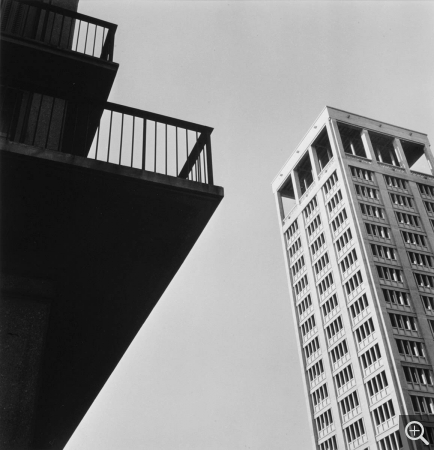Hervé, City Hall Tower from the ISAI
Lucien HERVÉ (1910-2007)
City Hall Tower from the ISAI
1956
silver halide photography – paper print
38 x 39 cm
© MuMa Le Havre / Lucien Hervé
City Hall Tower from the ISAI
1956
silver halide photography – paper print
38 x 39 cm
© MuMa Le Havre / Lucien Hervé
Born in Hungary, photographer László Elkán (1910–2007) moved to Paris in 1929 and joined the Resistance under the name Lucien Hervé. His encounter with Le Corbusier in 1949 had a decisive influence on his career. The architect's official photographer, he began working in the 1950s with a number of other artists such as Alvar Aalto, Pier Luigi Nervi, Marcel Breuer and Oscar Niemeyer, to name a few. He travelled the world working on a wide range of assignments (Chandigarh in 1955 and 1961, Brasilia in 1961, etc.).
In an effort to promote the modern image of the city of Le Havre rebuilt by Auguste Perret, the Délégation Générale du Tourisme commissioned a series of photographs from Lucien Hervé in 1956. Known as the "photographer specialized in architecture", he was to "provide images to illustrate a variety of documents distributed on the Atlantic steamers". Within a just few days, in July 1956, Lucien Hervé had taken four hundred shots. Two years after Perret's death (1954), the reconstruction of Le Havre was not yet complete, but the photographer, an ardent fan of the work of Le Corbusier—who had had a number of disputes with Perret—, succeeded in glorifying the modern and urban quality of this classic architecture.
He covered every inch of the city. The views shot from below, rather than from the front, allowed him to break with the regularity of an entire urban space founded on the pattern of vertical and horizontal lines. Hervé played with salient features (sharp edges of balconies, projections from surfaces) and powerful backlit effects for a rigorous structuring of his image. Once the contact prints were developed, he did not hesitate to rework his framing with scissors to find the ideal composition to the nearest millimetre for the finished print.
Although Hervé gave the first modern representation of the reconstructed city, his commission was nevertheless refused. The people of city were obviously not ready to accept the image he offered of Le Havre, for they had lost everything and were still deeply affected by the pain and loss of what had been destroyed in two days of bombing on September 5 and 6, 1944. Only a few images were chosen to illustrate a brochure published by the tourism office, and the rest of the contact prints and negatives were left unused. The photo campaign remained totally ignored until 2002, when a major exhibition on August Perret at the Musée Malraux and the Cité de l'Architecture in Paris led to the rediscovery, almost fifty years later, of over 400 contact prints in the city's archives and tourism office. Lucien Hervé provided his assistance and authorized prints to be made of thirty-three photographs of Le Havre. All were made under his close scrutiny, providing him with another opportunity to rework the framing of his images.
In an effort to promote the modern image of the city of Le Havre rebuilt by Auguste Perret, the Délégation Générale du Tourisme commissioned a series of photographs from Lucien Hervé in 1956. Known as the "photographer specialized in architecture", he was to "provide images to illustrate a variety of documents distributed on the Atlantic steamers". Within a just few days, in July 1956, Lucien Hervé had taken four hundred shots. Two years after Perret's death (1954), the reconstruction of Le Havre was not yet complete, but the photographer, an ardent fan of the work of Le Corbusier—who had had a number of disputes with Perret—, succeeded in glorifying the modern and urban quality of this classic architecture.
He covered every inch of the city. The views shot from below, rather than from the front, allowed him to break with the regularity of an entire urban space founded on the pattern of vertical and horizontal lines. Hervé played with salient features (sharp edges of balconies, projections from surfaces) and powerful backlit effects for a rigorous structuring of his image. Once the contact prints were developed, he did not hesitate to rework his framing with scissors to find the ideal composition to the nearest millimetre for the finished print.
Although Hervé gave the first modern representation of the reconstructed city, his commission was nevertheless refused. The people of city were obviously not ready to accept the image he offered of Le Havre, for they had lost everything and were still deeply affected by the pain and loss of what had been destroyed in two days of bombing on September 5 and 6, 1944. Only a few images were chosen to illustrate a brochure published by the tourism office, and the rest of the contact prints and negatives were left unused. The photo campaign remained totally ignored until 2002, when a major exhibition on August Perret at the Musée Malraux and the Cité de l'Architecture in Paris led to the rediscovery, almost fifty years later, of over 400 contact prints in the city's archives and tourism office. Lucien Hervé provided his assistance and authorized prints to be made of thirty-three photographs of Le Havre. All were made under his close scrutiny, providing him with another opportunity to rework the framing of his images.







